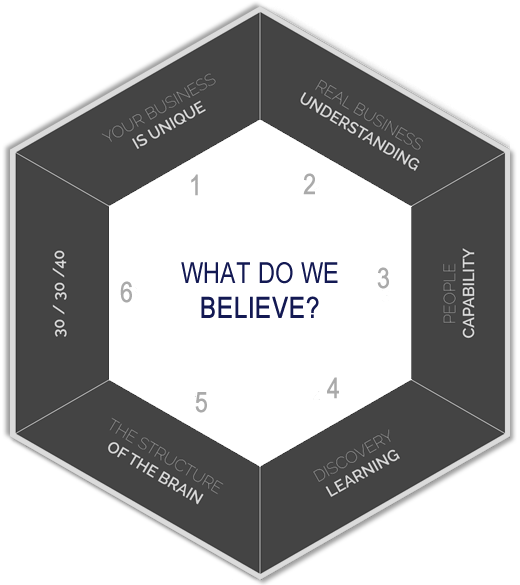Our Core Beliefs
Summary of our six core beliefs which underpin our approach to transforming people and organizations
![]() Click items to read more information
Click items to read more information
 Your Business is unique
Your Business is unique
We believe that every business is different. We identify your needs and develop a solution that will benefit your organization
Read more
In a business environment which is getting more competitive every day, companies need to constantly innovate and adapt their strategies to remain relevant, let alone grow. How can a “one size fits all” business simulation possibly support and build onto your unique business approach? We believe every business is different, hence the need to customize to clients requirements, either fully or partially.
 Real Business Understanding
Real Business Understanding
We deliver business understanding
through our unique methodology backed by our understanding of people and how their brains respond. Read more
Business Acumen is not just about understanding financial statements, but understanding the Big Picture of financial cause and effect. Managers and staff make strategic and operational decisions, often with limited understanding of the consequences of their decisions to the success of the entire business. Our simulations thus incorporate the different functions and drivers of your business, and cross departmental teams of participants make these decisions, and experience the results thereof, in the context of what your business is trying to achieve.
 People Capability
People Capability
Your managers and employees
gain the understanding of how they can positively and negatively impact your business.
Read more
Because of what we now know about the brain, we believe your people have the capability to develop a deep understanding of your business. It is commonplace on and after our simulations for managers and staff to surprise their senior colleagues not only with their comprehension of the business, but with relevant ideas to improve it.
 Discovery Learning
Discovery Learning
If I tell you something, it is true for me.
If you discover something, it's true for you. Read more
Our trainers will regularly hear the words AHAAA! during the simulation, and real company analysis, which is incorporated. We believe that telling management what they need to do, often without the context of why, is only a fraction as powerful as allowing them to make realistic decisions and experience realistic consequences. And thus come to their own realisations of why their company is doing what it is and why policies, targets, initiatives are actually sensible and need to be achieved. There’s no point in pushing information into your employees minds if their hearts are unwilling to accept or make use of the information. “If I tell you something it’s true for me, if you discover it is true for you.”
 The Structure of the Brain
The Structure of the Brain
Simulationsand courses are designed
around two key biological features of the brain: left & right brain and the limbic neocortex.
Read more
Courses are all designed to take advantage of 2 key biological features of the brain:-
Left & Right Brain: the left hemisphere is dominant in language: processing what you hear and handling most of the duties of speaking. It’s also in charge of carrying out logic and exact mathematical computations. When you need to retrieve a fact, your left brain pulls it from your memory. The right hemisphere is mainly in charge of spatial abilities, face recognition and processing music. It performs some math, but only rough estimations and comparisons. The brain’s right side also helps us to comprehend visual imagery and make sense of what we see. It plays a role in language, particularly in interpreting context and a person’s tone.
Limbic & Neocortex: The limbic system supports a variety of functions including adrenaline flow, emotion, behavior, motivation, long-term memory, and olfaction. Emotional life is largely housed in the limbic system, and it has a great deal to do with the formation of memories. The neocortex is involved in higher functions such as sensory perception, generation of motor commands, spatial reasoning, conscious thought and language
 30 / 30 / 40
30 / 30 / 40
30% - Experiental simulation / 30% - Reflective excersize / 40% - Transference to reality
Read more
CLIENT RELEVANCE: The simulation “game” is merely the platform used to transfer learnings to reality. The simulation must allow participants to grapple to similar issues as they do in their reality as well as have recognizable processes and realistic number relationships.
Our courses are design according to a 30/30/40 principle…
30% of time is spent on “playing the game”, 30% is spent on analysis and reflective exercises and the rest of the time (40%) is spent on transferring learning to their reality and discuss their real business issues.
